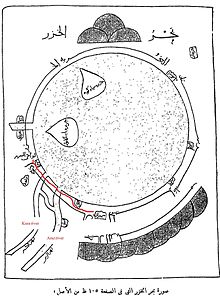Ibn Hawqal
This articleneeds additional citations forverification.(November 2015) |
Ibn Hawqal | |
|---|---|
| Born | |
| Died | after 978 |
| Academic background | |
| Influences | Al-Balkhi |
| Academic work | |
| Era | Islamic Golden Age |
| School or tradition | Balkhi school |
| Main interests | Islamic geography |
| Notable works | Ṣūrat al-’Arḍ |



Muḥammad Abū’l-Qāsim Ibn Ḥawqal(محمد أبو القاسم بن حوقل), also known asAbū al-Qāsim b. ʻAlī Ibn Ḥawqal al-Naṣībī,born inNisibis,Upper Mesopotamia;[1]was a 10th-centuryArab[2]Muslimwriter, geographer, and chronicler who travelled from AD 943 to 969.[3]His famous work, written in 977, is calledSurat Al-Ard(صورة الارض;"The face of the Earth" ). The date of his death, known from his writings, was afterAH368/AD978.
Biography
[edit]Details known of Ibn Hawqal's life are extrapolated from his book. He spent the last 30 years of his life traveling to remote parts ofAsiaandAfrica,and writing about different things he saw during his journey. One journey brought him 20° south of the equator along theEast Africancoast where he discovered large populations in regions theancient Greekwriters had deemed uninhabitable.[citation needed]
Ṣūrat al-’Arḍ
[edit]Ibn Hawqal based his great work of geography on a revision and augmentation of the text calledMasālik ul-MamālikbyIstakhri(AD 951), which itself was a revised edition of theṢuwar al-aqālīmbyAhmed ibn Sahl al-Balkhi,(ca. AD 921).[4][5]However Ibn Hawqal was more than an editor, he was a travel writer writing in the style followed later byAbu Ubaydallah al-Bakriin hisKitab al-Masālik wa-al-Mamālik,a literary genre which uses reports of merchants and travellers. Ibn Hawqal introduces 10th century humour into his account ofSicilyduring theKalbid-Fatimiddynasty. As a primary source his medieval geography tends to exaggeration, depicting the "barbaric and uncivilised" Christians ofPalermo,reflecting the prevailing politics and attitudes of his time. Yet his geographic accounts of his personal travels were relied upon, and found useful, by medieval Arab travellers.
The chapters onal-Andalus,Sicily, and the richly cultivated area ofFraxinet(La Garde-Freinet) describes in detail a number of regional innovations practiced by Muslim farmers and fishermen.
The chapter on theByzantine Empire—known in the Muslim world as, and called by the Byzantines themselves, the "Lands of the Romans" —gives his first-hand observation of the 360 languages spoken in theCaucasus,with theLingua Francabeing Arabic andPersianacross the region. With the description ofKiev,he may have mentioned therouteof theVolga Bulgarsand theKhazars,which was perhaps taken fromSviatoslav I of Kiev.[6]He also published a cartographic map ofSindhtogether with accounts of the geography and culture of Sindh and theIndus River.
Editions
[edit]An anonymous epitome of the book was written in AD 1233.[4]
In the 1870s, the famous Dutch orientalistMichael Jan de Goejeedited a selection of manuscript texts by Arab geographers, which was published byBrill,Leidenin the eight-volume seriesBibliotheca geographorum Arabicorum.Ibn Haukal's text was the second volume published in 1873 under the Latin titleViae et Regna, descriptio ditionis Moslemicae auctore Abu'l-Kásim Ibn Haukal- "Routes and Realms, a description of Muslim territories by the author Abu'l-Kásim Ibn Haukal".[citation needed]
See also
[edit]- Al-Maqdisi
- Ibn al-Faqih
- Qudama ibn Ja'far
- Ibn Khordadbeh
- Ibn Rustah
- Al-Ya'qubi
- Al-Masudi
- Muslim scholars
References
[edit]- ^Soucek, Svat,A History of Inner Asia(Cambridge University Press:2000), p.73.
- ^Jean-Charles, Ducène (January 2017)."Ibn Ḥawqal".Encyclopaedia of Islam, Three.
- ^Ludwig W. Adamec(2009),Historical Dictionary of Islam,p.137. Scarecrow Press.ISBN0810861615.
- ^abChisholm, Hugh,ed. (1911)..Encyclopædia Britannica.Vol. 14 (11th ed.). Cambridge University Press. p. 221.
- ^Şeşen 1999,p. 35.
- ^Encyclopedia of Ukraine
Further reading
[edit]- James, Preston Everett.All Possible Worlds: A History of Geography.New York: Wiley, 1981.
- Uylenbroek, P. J. (1822).Specimen geographico-historicum exhibens dissertationem de Ibn Haukalo geographo, nec non descriptionem Iracae Persicae cum ex eo scriptore tum ex aliis mss. arabicis bibl. L.B. petitam.Lugduni Batavorum (Leiden): Luchtmans, S. et J.OCLC905422872.
- Ibn Haukal (1873)."Viae et regna, descriptio ditionis moslemicae auctore Abu'l-Kasim Ibn Haukal".Inde Goeje,M. J. (ed.).Bibliotheca geographorum Arabicorum(in Arabic and Latin). Vol. 2. Lugdunum Batavorum (Leiden):Brill.
- Al-Istakhri, Abu Ishaq Ibrahim ibn Muhammad (1927),Goeje,M. J. de (ed.),"Viae Regnorum descriptio ditionis Moslemicae auctore Abū Ishāk al-Fārisi al-Istakhri",Bibliotheca Geographorum Arabicorum(in Arabic and Latin),1,Lugdunum Batavorum (Leiden): Brill
- Goeje,M. J. de, ed. (1870),"Indices, glossarium et addenda et emendanda ad Part I-III",Bibliotheca Geographorum Arabicorum(in Arabic and Latin),4,Lugdunum Batavorum (Leiden): Brill
- Gabrieli, Francesco (1961). "Ibn Ḥawqal e gli Arabi di Sicilia".Rivista degli studi orientali.36:245–253.JSTOR41879386.
- Şeşen, Ramzan (1999).IBN HAVKAL(in Turkish). Vol. 20 (Ibn Haldun - Ibnu'l Cezeri).TDV Encyclopedia of Islam.pp. 34–35.ISBN9789753894470.
External links
[edit]- Vernet, J. (2008) [1970-80]."Ibn Ḥawqal Abū'l-Qāsim Muḥammad".Complete Dictionary of Scientific Biography.Encyclopedia.com.
- Calvo, Emilia (1997)."Ibn Hawqal".InSelin, Helaine(ed.).Encyclopaedia of the history of science, technology, and medicine in non-western cultures.Kluer Academic Publishing.ISBN0-7923-4066-3.
